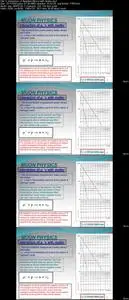Introduction to Cosmic Rays, Muon Physics, Berkeley Detector (Updated)
.MP4 | Video: 1280x720, 30 fps(r) | Audio: AAC, 48000 Hz, 2ch | 2.36 GB
Duration: 2.5 hours | Genre: eLearning | Language: English
Let learn about Berkeley Detector (Muon Detector), Muon Physics and also Cosmic Rays
.MP4 | Video: 1280x720, 30 fps(r) | Audio: AAC, 48000 Hz, 2ch | 2.36 GB
Duration: 2.5 hours | Genre: eLearning | Language: English
Let learn about Berkeley Detector (Muon Detector), Muon Physics and also Cosmic Rays
What you'll learn
Introduction to Cosmic Rays
BACKGROUND of COSMIC RAYS
What are Cosmic Rays?
Where do cosmic rays come from?
History of Cosmic Rays
Energy Level of Cosmic Rays
How many Cosmic Ray strike the ground?
Introduction to Muon Physics
Life Time of Muon
Observation of Cosmic Rays
Pierre Auger Observatory
Cosmic Ray Observation Project - CROP
The Berkeley Detector
Requirements
This course does not have any prerequisites.
Interesting Physics enough
Description
Introduction to Cosmic Rays, Muon Physics, Berkeley Detector
Last UPDATE : 16 July 2019
Cosmic rays include protons and also larger nuclei, are very energetic particules that continually bombard the earth. Speed of cosmic rays nearly speed of light - c -.
OUTLINE of this COURSE
I. BACKGROUND of COSMIC RAYS
What are Cosmic Rays?
Where do they come from?
History of Cosmic Rays
Energy Level of Cosmic Rays
How many Cosmic Ray strike the ground?
II. Muon Physics
Life Time of Muon
III. Observation of Cosmic Rays
Pierre Auger Observatory
CROP
The Berkeley Detector(*)
IV. References
Basic Downloadable Documents
Updated Thesis Documents of this Project *pdf (1.9 MB)
Upper Knowledge Downloadable Documents
Map of Basic Sciences
Modern Physics Summary Notes from MIT Lectures
More sources to listen, to read, to watch
The Berkeley detector is a highly portable coincidence muon detector is easy to use and easy to understand.
Energetic particles, traditionally called Cosmic Rays, were discovered nearly a hundred years ago, and their origin is still uncertain. Their main constituents are the normal nuclei as in the standard cosmic abundances of matter, with some enhancements for the heavier elements; there are also electrons, positrons and anti-protons, but no anti-nuclei.
Today we also have information on isotopic abundances, which show some anomalies, as compared with the interstellar medium. The known spectrum extends over energies from a few hundred MeV to 3*10^{20} eV and shows few clear spectral signatures: There is a small spectral break near 5*10^{15} eV, the "knee", where the spectrum turns down; there is another spectral break near 3*10^{18} eV, the "ankle", where the spectrum turns up again. Up to the ankle the cosmic rays are usually interpreted as originating from Galactic supernova explosions; however, we do not know what the origin of the knee is.
The particles beyond the ankle have to be extragalactic, it is usually assumed, because the Larmor radii in the Galactic magnetic field are too large; this argument could be overcome if those particles were very heavy nuclei as Fe, an idea which appears to be inconsistent, however, with the airshower data immediately above the energy of the ankle. Due to interaction with the cosmic microwave background there is a strong cut-off expected near 5*10^{19} eV, which is, however, not seen; The high energy cosmic rays beyond this "GZK-cutoff" (after its discoverers Greisen, Zatsepin and Kuzmin) are the challenge to interpret. We will describe the various approaches to understand the origin and physics of cosmic rays (abridged). (Cornell University, arXiv)
Who this course is for:
Any high school physics student should take this course.
Any college physics student should take this course.
Any university physics student should take this course.
Anyone who want to learn about Berkeley Detector
Anyone who want to learn about Muon Physics
Anyone who want to learn about Cosmic Rays
Bookmark My Blog & Visit it Daily for More Video Tutorial





